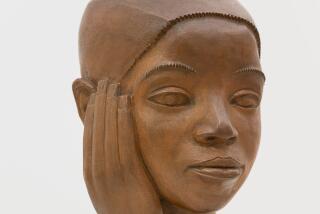Manoogian Collection : American Industrialist Waves the Flag With Art
- Share via
WASHINGTON — Detroit industrialist Richard Manoogian has collected a number of companies under his corporate banner, and it seems he collects American art the same way--with an enthusiasm and appetite for the best.
An exhibit drawn from his vast holdings, “American Paintings from the Manoogian Collection,” is on view for the first time at the National Gallery of Art, capturing what Gallery Director J. Carter Brown calls the essence of “a true collector.”
“He is more than a lender, more than an owner of art,” said Brown. “He is a true collector. All you have to do is go to his house and be careful if you have to get into the bathroom or into any or the closets or the kitchen. It is full of art.
“He is a joy to know because of this irrepressible enthusiasm he has for American art. What you are seeing here is just the tip of the iceberg. It was an agonizing choice to squeeze this collection down.”
Manoogian is chairman of the Masco Group, based in the Detroit suburb of Taylor. The conglomerate, which includes Masco Corp. and Masco Industries, has 300 manufacturing facilities in 29 states and 17 countries, involved in building, home improvement, automotive and heavy equipment.
The exhibit, an unparalleled survey of 19th-Century American painting from 1814 to 1920, runs through Sept. 4 in Washington and then travels through May, 1990, to San Francisco, New York and Detroit.
The 63 paintings on display feature works from every major school and tradition of the period--landscapes, trompe l’oeil, still lifes, genre scenes, impressionist landscapes and figure paintings. Portraiture includes major works by Thomas Eakins, John Singer Sargent and Mary Cassatt.
Landscapes include Jasper Francis Cropsey’s “The Backwoods of America” (1858), depicting a hearty pioneer family at a frontier settlement. William Bradford’s “Whalers Trapped in Arctic Ice” is a fine example of masterly paintings demonstrating the era’s expansive interest in the range and contrasts of geography.
Theodore Robinson’s “World’s Columbian Exhibition” (1894) is considered a masterpiece of American impressionism. George Caleb Bingham’s “The Jolly Flatboatmen,” (1846), one of the most famous paintings in the collection, shows a boatman dancing on top of a flatboat while a fiddler plays and a crew mate keeps time with a frying pan.
Nicolai Cikovsky, curator of American art at the National Gallery, called the exhibit “a comprehensive survey of American painting, a remarkable one in capsule form.”
“What I think is remarkable and distinctive about this collection is how it ranges widely from the canonic to the offbeat to the mainstream to the idiosyncratic, and I mean that as a compliment.
“It never loses its essential flavor as a private, personally formed, personally determined collection. It also captures very purposely the flavor of American art--its rawness, its tentativeness, but also its daring, its boldness and its excitement.”
Manoogian explained his voracious collecting habits in terms of a goal--to give this particular genre its rightful place in the public consciousness--and in terms of his personal sense of patriotism.
“I think one of the main motivations was just the feeling that American art generally was often underappreciated,” he said. “Hopefully, one of the things that this exhibition will do is show the quality and diversity that exists in American art . . . and will encourage other people to build that appreciation.
“It partly also reflects a deep-seated feeling for this country that my family’s had going back for many years. Putting this collection together and sharing it is just a small way of expressing that appreciation for all the opportunities this country has presented for families such as ours.”
“American Paintings from the Manoogian Collection” also will be on view at the M.H. de Young Memorial Museum in San Francisco, Sept. 23 to Nov. 26; the Metropolitan Museum of Art in New York, Dec. 19 to Feb. 25, 1990; and the Detroit Institute of Arts, March 27 to May 27, 1990.
More to Read
The biggest entertainment stories
Get our big stories about Hollywood, film, television, music, arts, culture and more right in your inbox as soon as they publish.
You may occasionally receive promotional content from the Los Angeles Times.










